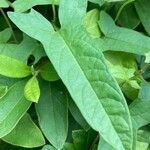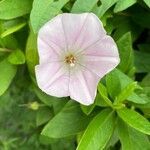Plants glabrous. Stems erect when young, later shoots prostrate or twining, to 1 m. Petiole 1--5 cm; leaf blade sagittate, triangular to narrowly triangular, 2--8 X 2--7 cm including lobes; lobes abruptly spreading, with 2(or 3) acute angles, sinus with divergent sides. Lower peduncles exceeding leaves, upper peduncles shorter; bracteoles ± ovate, 0.7--1.4(--1.8) cm X (4--)6--10(--12) mm, flat, apex acute to ± obtuse. Corolla pale pink or occasionally whitish or purplish, 2--3.5 cm. Stamens 1.1--1.6(--1.9) cm; anthers 3--4 mm. Fl. Mar-Sep, fr. Jun-Sep. 2n = 22, 30.
Stems climbing or trailing; lvs hastate, 4–8 cm, the terminal lobe oblong, the basal lobes acute, often 2–3-angled; fls pink, 2–3.5 cm; 2n=22. Native of Japan, the double-fld form (“California rose”) occasionally cult. and escaped along roadsides etc. in much of our range. The rarely cult. single-fld form is reported as an adventive weed in Pa. (C. japonica, a preoccupied name; Convolvulus japonicus; Convolvulus pellitus; Convolvulus wallichianus)
A climbing herb. It keeps growing from year to year. The shoots can climb or lay along the ground and are 3 m long. The leaves are green and arrow shaped. The flowers are pink and 5 cm across.




